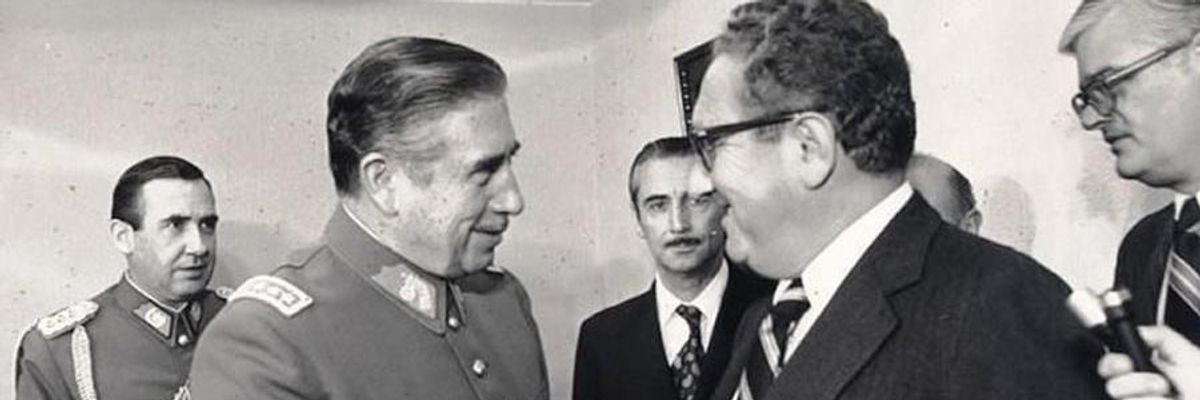September 11, 2023, marks the 50th anniversary of General Pinochet’s military coup against Chilean President Salvador Allende. While it is now widely recognized that Pinochet authorized large-scale human rights abuses, there is an accompanying narrative that he also unleashed an economic miracle via embrace of Milton Friedman’s “Chicago Boys” vision of a market economy.
The “Pinochet economic miracle” narrative is profoundly misleading. Worse yet, it is a political menace for two reasons. First, it risks tacitly promoting the notion that dictatorship may be legitimate to the extent it offers a road to prosperity. Second, the Pinochet regime embraced Neoliberalism which promotes anti-democratic tendencies by fracturing society. The claim of a Pinochet economic miracle lends support to Neoliberalism, thereby encouraging acceptance of Neoliberalism despite its anti-democratic proclivities.
For those reasons, debate over Pinochet’s economic policy remains of vital importance. The 50th anniversary of Pinochet’s coup is an opportunity to challenge the pernicious miracle myth which is increasingly part of the conventional wisdom.
Debunking the Pinochet economic miracle myth
Tackling the Pinochet myth is difficult. First, advocates of Neoliberalism seek to turn the debate into one about the socialist policies of President Salvador Allende, thereby changing topic. Second, economies are complex, so that a true measure of the Pinochet effect requires subtracting gains from other sources.
By way of beginning, it is worth noting that President Allende’s economic program was subject to extraordinary economic sabotage sponsored by Chile’s elites and the US. The 1972 Chilean trucker strike was assisted by the CIA, paralyzed the economy, and caused inflation to soar. U.S. multinational corporations went on an investment strike (with U.S. government approval), and there was also a stop on buying Chilean copper which crushed Chile’s foreign exchange earnings. Allende’s government was beset by internal disorder and its program might have failed anyway. However, it is doubtful any developing economy could succeed in the face of such a concerted economic assault.
That said, the myth argument is about Pinochet’s policies, and not Allende’s. The argument begins by recognizing that Chile was subject to two rounds of “Chicago Boys” shock therapy, and the first round has been totally written out of the Pinochet miracle narrative. That first round (1975-1982) ended in a devastating economic crisis in which per capita income fell below that of 1960. The crisis was resolved by a massive government bailout of the banking system. It provides a classic example of what has become a standard feature of Neoliberalism, with financial bailouts being part of the mechanism whereby Neoliberalism concentrates wealth. More than that, it also illustrates how Neoliberalism persistently requires government to rescue it from itself.
The 1982 economic crisis was followed by a second round of Chicago Boys policy which is associated with greater macroeconomic success. The bailout re-established financial stability, and the 1980s can be viewed as a period of long recovery from the depths of an economic depression. In that regard, parallels can be drawn with Argentina in the 2000s.
In the 1990s other factors kicked in. Chile is one of the world’s leading copper exporters, and the last 25 years have been a boom period for copper. Additionally, Chile is a major exporter of lithium, which has become another boom commodity over the past decade. The implication is much of Chile’s macroeconomic success is due to its unique resource endowment which matched the times, rather than Pinochet’s turn to Neoliberalism.
That said, there was a macroeconomic gain from the Chicago Boys’ policies which transformed Chile into the posterchild of Neoliberalism. That gain came from making Chile a haven for international capital and then inserting Neoliberalized Chile into the emerging Neoliberal globalized economy in the 1990s. However, the macroeconomic gain came at the cost of a suppressed wage share and a high capital share, so that Chile had the highest income inequality in the OECD in the late 2000s.
Since 2010, there has been some reduction in inequality. However, it can be reasonably argued that improvement is because of Chile’s natural resource base and and not because the economic model is good. That explains the apparent paradox whereby ordinary Chileans have vigorously protested the model despite its surface macroeconomic success.
One final point is that Pinochet also persisted with many state-led innovations from the past. Thus, copper mining remained under public ownership and Chile still has a national health system. That further reinforces the argument that there was no “Pinochet economic miracle”. Instead, Pinochet’s effect was to move Chile in an oppressive and inegalitarian direction. In sum, not only does the economic miracle myth give indirect support for authoritarianism, but it also makes grossly false claims about the economic benefits of Neoliberalism.
Conclusion: a dangerous double movement
The last 30 years have seen a double movement which acknowledges Pinochet’s human rights abuses, but then subtly excuses them on grounds that he unleashed an economic miracle. The claim of a Pinochet economic miracle is false, and it is also politically dangerous in the tacit support it gives to dictatorship and Neoliberalism.
Myths are always difficult to debunk. The Pinochet economic miracle myth is especially difficult as it is pushed by both “hardcore” politically conservative Neoliberal economists and their more compassionate “softcore” liberal colleagues.
It is critical that we get Chile’s economic record right as the debate has implications far beyond economics. The reality is General Pinochet is an enduring example of the evils of dictatorship. The coup against Allende provides a window on the realities of U.S. foreign policy behavior. Chile’s macroeconomic success is significantly due to its natural resource endowment and the legacy of past state-led interventions. The Chilean economy is a poster child for the economic contradictions of Neoliberalism, in which the “best” perform poorly and their only claim to merit is that others perform worse. Lastly, the myth of a Pinochet economic miracle lends cruel support to anti-democratic tendencies.
